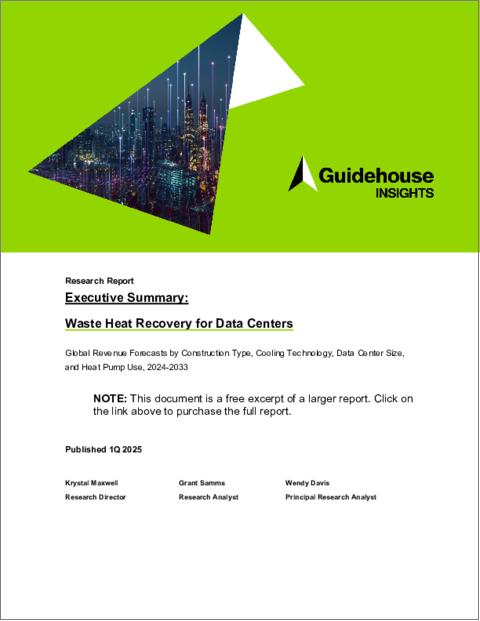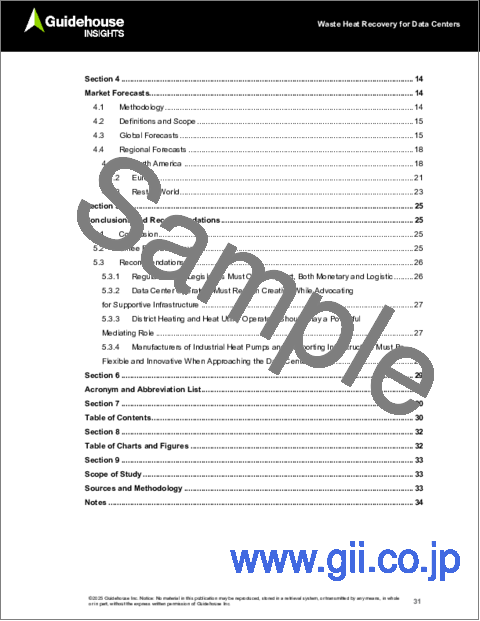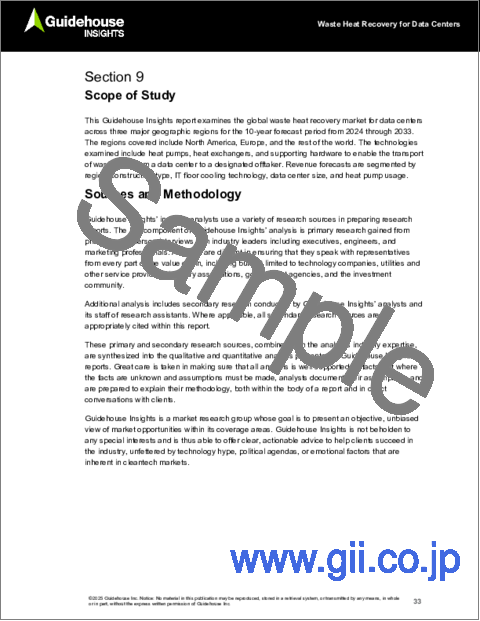|
|
市場調査レポート
商品コード
1645200
データセンター向け廃熱再利用の世界市場:収益予測 - 建設タイプ別、冷却技術別、データセンター規模別、ヒートポンプ使用別(2024年~2033年)Waste Heat Reuse for Data Centers: Global Revenue Forecasts by Construction Type, Cooling Technology, Data Center Size, and Heat Pump Use, 2024-2033 |
||||||
|
|||||||
| データセンター向け廃熱再利用の世界市場:収益予測 - 建設タイプ別、冷却技術別、データセンター規模別、ヒートポンプ使用別(2024年~2033年) |
|
出版日: 2025年01月28日
発行: Guidehouse Research
ページ情報: 英文 35 Pages
納期: 即納可能
|
全表示
- 概要
- 目次
データセンター向け廃熱再利用市場は、現在はまだ始まったばかりですが、すでに家庭や企業、製造施設の暖房を脱炭素化しつつあります。国際エネルギー機関(IEA)によると、データセンターの規模、数、電力需要は急速に拡大しており、早ければ2026年までに世界全体の電力消費量が倍増すると予想されています。データセンターが成長を続けるにつれ、再利用を可能にするインフラが整備されれば、持続可能な目標を達成するために、排出のない熱を大量に利用できるようになります。現在、データセンターの廃熱回収の最も一般的な用途は、地域暖房、空間暖房、給湯、農業、養殖、低品位プロセス暖房などです。
今日のデータセンター廃熱回収市場の主な促進要因は、新しいデータセンターの急速な開発と、世界の気候変動緩和政策の一般的な増加です。その他の促進要因としては、廃熱回収の機会に対する潜在的な引き取り手の意識の高まりや、データセンターと引き取り手の双方における企業の持続可能性目標の高まりが挙げられます。廃熱回収のさらなる普及を阻む最大の抑制要因は、適切な伝熱インフラの不足です。さらに、廃熱回収システムの既存施設への改造には多大なコストがかかるため、今日の廃熱回収のほとんどは新設のデータセンターで行われています。データセンターとオフテーカーを組み合わせるための政府の政策や物流支援、熱輸送ネットワークの整備は、こうした障壁を減らすための重要な方法です。
当レポートは、世界のデータセンター向け廃熱再利用市場について調査し、現在の市場問題、技術動向、市場促進要因、抑制要因、政策状況などを分析しています。市場セグメンテーションでは、2033年までの収益と予測を示し、地域別、建設タイプ別、データセンターの冷却技術別、ヒートポンプ使用別に区分しています。
目次
第1章 エグゼクティブサマリー
第2章 市場の問題
- イントロダクション
- 促進要因
- 抑制要因
第3章 産業バリューチェーン
- 競合情勢
- M&Aおよび投資活動
- ビジネスモデルの進化
第4章 市場予測
- 調査手法
- 定義と範囲
- 世界の予測
- 地域予測
- 北米
- 欧州
- その他
第5章 結論・提言
- 結論
- 3つの大きなポイント
- 推奨事項
第6章 頭字語と略語一覧
第7章 目次
第8章 図表
第9章 調査範囲、情報源と調査手法、注釈
The market for the reuse of waste heat from data centers, while currently nascent, is already decarbonizing heating for homes, businesses, and manufacturing facilities. Data centers are rapidly growing in size, number, and electricity demand and are expected to double in power consumption globally by as soon as 2026 according to the International Energy Agency. As data centers continue to grow, a large capacity of emissions-free heat will be available to meet sustainability goals if infrastructure is in place to enable it to be reused. The most common applications of data center waste heat recovery currently include district heating, space heating, water heating, agriculture, aquaculture, and low grade process heating.
The primary driver of the data center waste heat recovery market today is the rapid development of new data centers paired with a generally increasing level of climate change abatement policies globally. Other drivers include increasing awareness of the opportunities for waste heat recovery among potential offtakers, and growing corporate sustainability goals for both data centers and offtakers. A lack of suitable heat transfer infrastructure is the single largest barrier to further adoption of waste heat recovery. Additionally, most waste heat recovery today occurs in newly built data centers, as retrofitting a heat recovery system into existing facilities involves significant costs. Government policies and logistic support for pairing data centers with offtakers, as well as the development of heat transfer networks, are key ways to reduce these barriers.
This Guidehouse Insights report examines the global market for data center waste heat recovery, analyzing current market issues, technology trends, drivers, barriers, and the policy landscape. Market forecasts are presented for revenue through 2033 and are segmented by region, construction type, data center cooling technology, and heat pump usage.
Table of Contents
1. Executive Summary
- 1.1 State of the Market
- 1.2 Market Drivers and Barriers
- 1.3 Market Forecasts
2. Market Issues
- 2.1 Introduction
- 2.1.1 Technology Definitions
- 2.1.2 Use Cases and End Users
- 2.2 Drivers
- 2.2.1 Growing Data Center Demand
- 2.2.2 Government Mandates, Policies, and Incentives
- 2.2.2.1 North America
- 2.2.2.2 Europe
- 2.2.2.3 Asia Pacific
- 2.2.3 Waste Heat End User Growth
- 2.2.4 Sustainability Goals
- 2.3 Barriers
- 2.3.1 Lack of Existing Infrastructure
- 2.3.2 Generally Low Grade of Heat
- 2.3.3 Seasonality and Offtaker Availability
- 2.3.4 Expensive Retrofit Options
3. Industry Value Chain
- 3.1 Competitive Landscape
- 3.1.1 M&A and Investment Activities
- 3.1.2 Business Model Evolution
- 3.1.2.1 Value of Heat
- 3.1.2.2 Emerging Market Approaches
4. Market Forecasts
- 4.1 Methodology
- 4.2 Definitions and Scope
- 4.3 Global Forecasts
- 4.4 Regional Forecasts
- 4.4.1 North America
- 4.4.2 Europe
- 4.4.3 Rest of World
5. Conclusions and Recommendations
- 5.1 Conclusion
- 5.2 Three Big Takeaways
- 5.3 Recommendations
- 5.3.1 Regulators and Legislators Must Offer Support, Both Monetary and Logistic
- 5.3.2 Data Center Operators Must Remain Creative While Advocating for Supportive Infrastructure
- 5.3.3 District Heating and Heat Utility Operators Should Play a Powerful Mediating Role
- 5.3.4 Manufacturers of Industrial Heat Pumps and Supporting Infrastructure Must Be Flexible and Innovative When Approaching the Data Center Market





